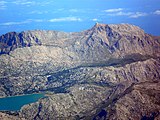Serra de Tramuntana
| UNESCO World Heritage Site | |
|---|---|
 | |
| Location | Majorca |
| Criteria | Cultural: ii, iv, v |
| Reference | 1371 |
| Inscription | 2011 (35th Session) |
| Coordinates | 39°43′51″N 2°41′41″E / 39.73083°N 2.69472°E |
The Serra de Tramuntana (Catalan pronunciation: [ˈsɛrə ðe tɾəmunˈtanə], Template:Lang-es) is a mountain range running southwest-northeast which forms the northern backbone of the Spanish island of Majorca. It is also the name given to the comarca of the same area. On the 27th June 2011 The Tramuntana Range was awarded World Heritage Status by UNESCO as an area of great Physical and Cultural significance.
Geography
The highest peak is the Puig Major, which, at its 1,445 metres is the highest mountain in the Balearic Islands. It is closely followed by the Puig de Massanella, which stands at 1,364 metres.
The climate in the Tramuntana Range is significantly wetter than the rest of the island, recording as much as 1507 mm (59.3 inches) of precipitation per year, in comparison with some other parts of the island where annual rainfall is less than 400mm (15 inch). It is also cooler due to the height and a few days of snow are not unusual during winter.
The Serra de Na Burguesa is the southernmost portion of the Tramuntana Range.
Municipalities in the region

| Municipality: | Population | Surface | Pop/km² |
| Andratx | 11,348 | 81.45 km² | 139.3 |
| Banyalbufar | 627 | 18.05 km² | 34.7 |
| Bunyola | 5,910 | 84.63 km² | 69.8 |
| Calvià | 50,777 | 144.97 km² | 350.3 |
| Deià | 754 | 15.12 km² | 49.9 |
| Escorca | 276 | 139.33 km² | 2.0 |
| Esporles | 4,696 | 35.27 km² | 133.1 |
| Estellencs | 388 | 13.39 km² | 29.0 |
| Fornalutx | 732 | 19.49 km² | 37.6 |
| Pollença | 16,997 | 151.44 km² | 116.4 |
| Puigpunyent | 1,763 | 42.28 km² | 41.7 |
| Sóller | 13,625 | 42.75 km² | 318.7 |
| Valldemossa | 1,977 | 42.84 km² | 46.2 |
Population as at 01 Januar 2008
Environmental protection
In June 2011, the entire mountain range, which has been preserved as an important nature reserve, outstanding in their geology and forest cover and harboring a diversity of plant and animal species, away from rapid urbanization,was listed as a World Heritage Site by UNESCO. The UNESCO introductory statement refers to:
The Cultural Landscape of the Serra de Tramuntana located on a sheer-sided mountain range parallel to the north-western coast of the island of Mallorca. Millennia of agriculture in an environment with scarce resources has transformed the terrain and displays an articulated network of devices for the management of water revolving around farming units of feudal origins. The landscape is marked by agricultural terraces and inter-connected water works - including water mills - as well as dry stone constructions and farms.[1]
Gallery
-
Coastal Side of the Serra de Tramuntana
-
Lakes Cúber and Gorg Blau
-
Puig Major
-
Puig d'Ofre
-
Morro de sa Vaca
-
Sa Calobra
External links
 Serra de Tramuntana travel guide from Wikivoyage
Serra de Tramuntana travel guide from Wikivoyage- Serra de Tramuntana - UNESCO World Heritage status 2010, Cultural Landscape Template:Ca icon Template:Es icon Template:En icon
- Serra de Tramuntana
- Trail across all the Serra de Tramuntana
- Information on the Serra de Tramuntana Template:Ca icon
- Serra de Tramuntana of Mallorca, World Heritage Site
- Serra de Tramuntana - Facebook
- Serra de Tramuntana - Twitter
- Serra de Tramuntana







